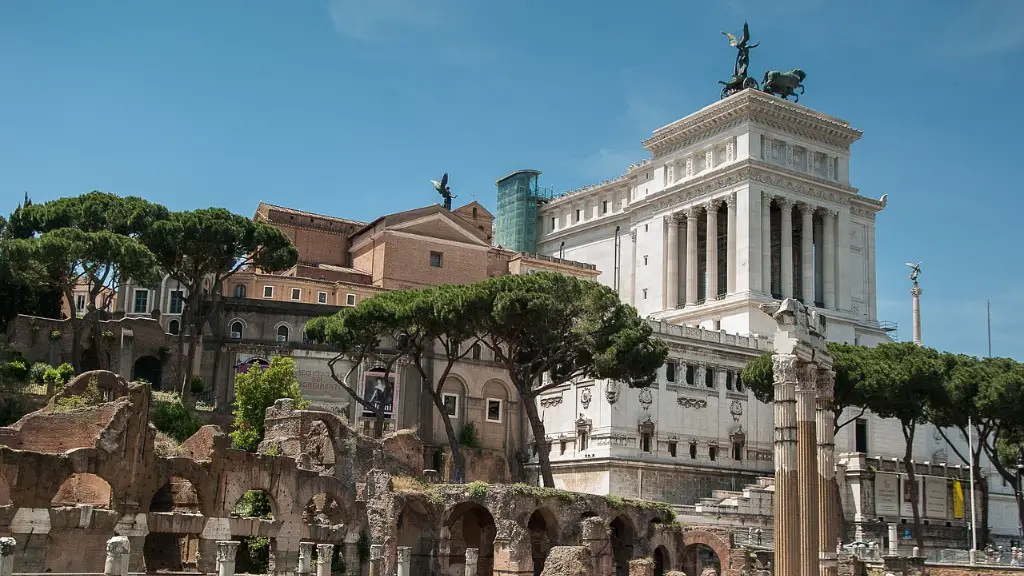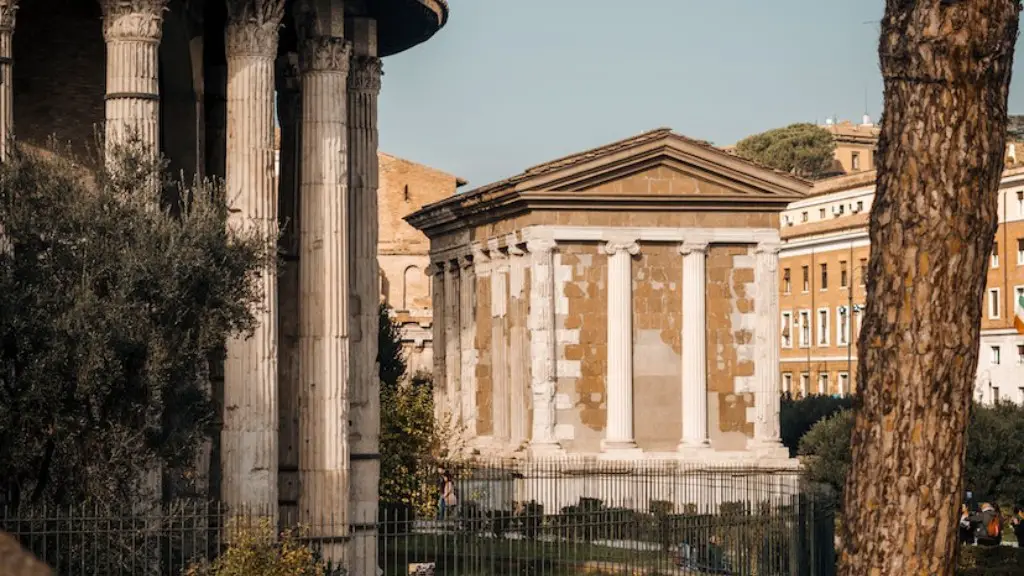Ancient Rome Impact On Society
Ancient Rome has made a lasting impact on modern society through its art, engineering, language, politics and many more aspects, and therefore, studying this ancient civilization is still highly relevant. Archaeological research into the past of Rome, and its interconnectedness with other contemporary societies, provides a detailed, holistic perspective of its culture and heritage, which may be lost as time passes.
From archaeological evidence, it is clear that nearly 2000 years ago, Rome was an urban center of activity. The Forum, a grand public area located in the center of the city, was a political, cultural, and religious hub. The Colosseum, an impressive engineering feat, was used for public entertainment and spectacular battles. Aqueducts, sewers, and water systems connected the city in ways that still today make the engineering feats of Ancient Rome a wonder.
Linguistically, Latin has had a significant influence on modern English, as well as other languages in the Romance family. Latin was the language of authoritative pronouncements and of scientific & legal works. From its various manifestations, words from Latin are found everywhere in English, and are evidenced in the rich vocabulary still used in study of ancient Roman culture today.
Ancient Roman art has also been influential on modern culture. Statues, coins, pottery, jewellery, and many other important pieces of art were produced in large quantities since the early Republic. Sculpture, painting, architecture, and mosaics of Ancient Rome are widely admired.
An analysis of ancient Rome’s political life is essential to fully understanding its rise and fall. The government of Rome was often disposed to support the patricians among the citizens, while always honoring the powers of the people. The Roman Senate was also essential, consisting of the most prominent men of Rome.
Legislation in Ancient Rome
Ancient Rome had a very developed legal system; first originating from the Twelve Tables, and eventually from the Codes of Justinian. Roman legal codes, such as the Twelve Tables, formed the basis for most of Europe’s legal systems in later years and provided the mould for those now governing modern democracies.
Roman law was organized around three core areas: civil law, public law and criminal law. Civil law dealt with property, public law was concerned with the government and politics, and criminal law provided definitions for offences and punishments. The Twelve Tables, supposedly first written in the 5th century B.C., provided the first codified system of laws in Ancient Rome, which were later developed further into Justinian’s codes.
Cicero, one of the most famous Roman orators and lawyers, played a major role in the development of Roman law. He studied law in depth and created a compilation of Roman law which was used for over 1000 years and served as a foundation for the further development of Roman law.
Roman Civilisation’s Reflection On Modern Culture
There is no doubt that Roman culture, and its subsequent civilizations, continue to shape modern life in many areas. As a polytheistic society, Ancient Rome brought in new gods, rituals, and beliefs to the ancient pantheon of gods, as distinct from the traditional Semitic monotheism that was dominant in the West at the time. This evolution in religious thought enabled the development of concepts such as heaven, hell and eternity, which still exist to this day.
The Roman Empire also laid the foundation for two distinct political parties in its Senate. While representing the upper class patricians, each team had its own platform and many of the issues of today are still very similar to those of ancient Rome, with the Left and Right at odds over key policies and often disagreeing on ideology. This model has remained more or less unchanged and is at the heart of modern democracies.
Roman Impact On Infrastructure and Trade
Ancient Rome also crafted a strong infrastructure across Europe, which provided a foundation for later Europeans to build upon. The Roman roads, lavishly engineered aqueducts, sewers and walls, were built to last and have endured to this day. An example of this are the roads built by Claudius, which stretched over 6,000 miles and remained usable for centuries afterwards.
Additionally, the Roman government gave rise to strong trading practices and a unified monetary system which allowed for an expansive trading network with its colonies and other civilizations.
Impact Of Ancient Rome On Art
Ancient Rome was a vibrant culture of art and architecture, which left a lasting legacy on modern civilization. From the Roman Forum, the eternal city of Rome, the great monuments, and the imposing statues, its art has had a profound influence on art and architecture in the modern world.
One of the most famous pieces of art associated with Ancient Rome is the David sculpture, a masterpiece sculpted by the great Italian Renaissance artist Michelangelo. The sculpture, originally meant to be placed in the Florence Cathedral, is a representation of David, the Jewish hero who famously fought Goliath in battle. The statue is considered a masterpiece, not just because of its beauty, but also its symbolic significance in expressing the spirit of the times.
Roman Empire mosaics are another well-known example of art that has been studied and admired for its symbolism, beauty and detail. Featuring multi-colored, geometric patterns, detailed figures, and a variety of motifs, mosaics found in ancient ruins are some of the most elaborate and well-preserved pieces of art remaining from the era.
The Legacy Of Ancient Rome For Future Exploration And Research
It is clear that the legacy of Ancient Rome will continue to live on not just in our understanding of the past, but also in the present and future of our culture. Through its incredible architecture, art, politics and legal systems, ancient Rome continues to challenge the imagination and shape our world today.
Studying Ancient Rome always has and will remain an essential piece of understanding. Pursuing research and exploration into this major period of history can provide a bridge between then and now, and give important lessons for the future. It will also inform our perceptions of societies and our own place in history, leading to a deeper appreciation for the past and a better understanding of the present.
Significance Of Understanding Ancient Rome For Future Advancement
By studying Ancient Rome, we can better understand its immense impact on our lives today and the legacy it left for other civilizations in the future. Ancient Rome serves as a powerful reminder of the importance of interconnectivity, a foundational concept in all societies.
Rome, particularly its citizens, left behind a blueprint for living, not just in a thriving, international city, but one in which to enjoy a healthy lifestyle and all that life brings. The culture and laws of Ancient Rome may be thousands of years old, but they still carry weight and meaning, preparing us for the challenges of the future.
Ancient Rome’s engineering also provides an example of how to maximize the efficiency of a large scale operation. Rome’s canals, aqueducts and defensive walls helped to give the city an edge over its competitors and allowed it to become an empire.
Influence Of Ancient Rome On Education, Literature and Music
Ancient Rome has had an undeniable influence on education and literature. The Roman educational system was highly developed and focused on creating individuals with general skills, equipped with fitness and warfare, law, medicine veterinary medicine, and architecture.
The Latin language of Ancient Rome formed the language for official reports, legal documents and writings about literature, history, science and philosophy. In European literature, Ancient Rome features prominently, often in translations of Latin classics such as Tacitus, Cicero and Vergil, or as a backdrop to works by contemporary authors.
The musical prowess of ancient Rome can be seen in its compositions of music, as well as its capture of musical technology and instruments throughout the Mediterranean region. From the small aulos, to larger scale orchestras, ancient Roman musicians found their place in society and left behind a unique tribute to their culture.
Conclusion Of Ancient Rome’s Enduring Legacy
The legacy of Ancient Rome is evident in our lives today. From its influence on language and literature, to its lasting footprints in our modern-day politics, infrastructure, art and music, Rome’s impact is still strongly felt and serves as a reminder of a powerful and enduring civilization. Understanding Ancient Rome and its impact on our culture and history is essential to our own understanding of the world.


